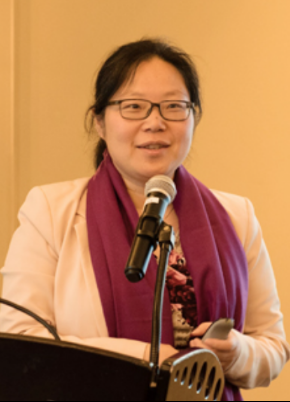
Plenary Speaker
Qinghua Zheng, Academician of Chinese Academy of Engineering, CCF Fellow, CAAI Fellow, Winner of National Science Fund for Distinguished Young Scholars of China, President of Tongji UniversityTongji University, China郑庆华,汉族,1969年1月出生,浙江嵊州人,博士,教授,中国工程院院士,CCF Fellow,CAAI Fellow,现任同济大学校长(副部长级)、党委副书记。国家杰出青年基金获得者,长江学者特聘教授,首批国家“万人计划”科技创新领军人才,教育部科技委学部委员,教育部大学计算机教学指导委员会主任,国家自然科学基金创新群体负责人,智能网络与网络安全教育部重点实验室主任。 长期从事大数据知识工程研究,在IEEE TPAMI、TKDE、IJCAI等发表论文190余篇,由科学出版社出版《大数据知识工程》等专著3部,主持国家863计划、国家科技支撑计划、核高基重大专项、国家自然科学基金重点、国家科技创新2030-“新一代人工智能”重大专项等40余项科研项目。研究成果在数字教育、国家金税工程等实现重大应用,获国家科技进步二等奖3项、国家级教学成果一等奖2项和二等奖3项、省部级科学技术一等奖5项,获2022年度何梁何利基金“科学与技术进步奖”,中国自动化学会科技进步特等奖。先后获得中国科协“求是”杰出青年奖、中国青年科技奖、国务院政府特殊津贴专家、宝钢优秀教师特等奖、全国高等学校优秀骨干教师、全国信息产业科技创新先进工作者等荣誉。 Speech Title: 人工智能赋能创建未来教育新格局 |
|
| Zhengyou Zhang, ACM Fellow, IEEE FellowChief Scientist of Tencent AILab, Tencent, ChinaDr. Zhengyou Zhang (ACM Fellow and IEEE Fellow) is the Chief Scientist at Tencent, China, and the Director of Tencent Robotics X since March 2018. Before that, he was a Partner Research Manager with Microsoft Research, Redmond, WA, USA, for 20 years. Before joining Microsoft Research in March 1998, he was a Senior Research Scientist with INRIA (French National Institute for Research in Computer Science and Control), France. In 1996-1997, he spent a one-year sabbatical as an Invited Researcher with the Advanced Telecommunications Research Institute International (ATR), Kyoto, Japan. He is the Founding Editor-in-Chief of the IEEE Transactions on Cognitive and Developmental Systems, is on the Honorary Board of the International Journal of Computer Vision and on the Steering Committee of the Machine Vision and Applications, and serves or served as an Associate Editor for many journals. He received the IEEE Helmholtz Test of Time Award for his paper published in 1999 on camera calibration, now known as Zhang’s method. According to Google Scholar, his h-index is over 105, and he has over 75K citations. He has over 250 patents issued. Speech Title: Generative AI and Embodied AI Abstract: We draw inspiration from Kahneman’s human intelligence theory about system 1 and system 2 thinking, and propose a hierarchical learning framework, called “SLAP”, to enable legged robots to exhibit lifelike agility and strategy in complex environments. Our approach moves beyond conventional task-specific controllers and end-to-end RL methods by pre-training generative models on animal motion datasets, thus retaining extensive knowledge of animal behavior. The framework goes from this environment-agnostic primitive-level controller, up through the environment-level controller to adapt to various environments, and finally into the strategic-level controller to tackle complex downstream tasks. This flexible framework allows for continuous accumulation of knowledge at different levels without affecting the usage of other knowledge levels. We successfully apply the multi-level controllers to the MAX robot, an in-house developed quadrupedal robot, enabling it to mimic animals, navigate complex obstacles, and participate in a challenging multi-agent Chase Tag Game, where lifelike agility and strategy emerge. |
Z. Jane Wang, IEEE FellowECE Dept, University of British Columbia (UBC), CanadaZ. Jane Wang received the B.Sc. degree from Tsinghua University in 1996 and the M.Sc. and Ph.D. degrees from the University of Connecticut in 2000 and 2002, respectively, all in electrical engineering. She has been Research Associate at the University of Maryland, College Park from 2002 to 2004. Since 2004, she has been with the ECE dept. at the University of British Columbia (UBC), Canada, and she is currently Professor. She is Fellow of IEEE and the Canadian Academy of Engineering (FCAE). Her research interests are in the broad areas of signal processing and machine learning, with current focuses on digital media security and biomedical data analytics. She has been key Organizing Committee Member for numerous IEEE conferences and workshops (e.g. Technical Chair or General Chair for IEEE ICIP 2020, 2025 and 2026). She has been Associate Editor for the IEEE TSP, SPL, TMM, TIFS, TBME, and SPM, and Editor-in-Chief for the IEEE Signal Processing letters. Speech Title: 2D-Image Based Pose Estimation for Healthcare Applications Abstract: Healthcare systems are complex and challenging, however deep learning has been revolutionizing healthcare. Keypoint-based pose estimation is an important learning topic with board applications in medical and healthcare systems. As 2D images are cost effective and easy to capture, keypoint detection using 2D images has been attracting increasing research interest. This talk gives a brief review of my group’s recent research efforts in exploring 2D-image based pose estimation, from both methodology and healthcare application aspects, by investigating: 3D human pose estimation; hand pose estimation; pose estimation based assessments in Parkinson’s Disease; and keypoint based pose assessments using horse images. Particularly, a critical concern in real-world problems is the scarcity of annotated data. We propose innovative strategies (e.g., self-supervision, partial annotation, data synthesis) for training deep learning models without or reducing the need for explicit annotated data. The talk will conclude by brainstorming future research directions. |
|
| Ronghua Liang, Vice President of Zhejiang University of Science and TechnologyZhejiang University of Science and Technology, ChinaRonghua Liang is the vice president of Zhejiang University of Science and Technology. He was selected as a leading talent in science and technology innovation in the National Ten Thousand People Plan Program of the government, a leading talent in science and technology innovation of the Ministry of Science and Technology, an outstanding talent in the new century by the Ministry of Education, is entitled to a special government allowance from the State Council, and is an expert with outstanding contributions among young and middle-aged experts in Zhejiang Province, etc. His research interests covers the perception and understanding of multimodal image data and other fields. He has got over 20 national and provincial projects as PI, such as the National Key R&D Plan Project, the National Natural Science Foundation Major Instrument, and the Key Project of the National Natural Science Foundation. He has published more than 150 academic papers on journals such as IEEE TPAMI, TVCG, TKDE, etc.. He as the first completer has won the first prize of the Zhejiang Province Natural Science Award, the first prize of the Zhejiang Province Science and Technology Progress Award, the China Patent Excellence Award. He serves as the head of the Engineering Research Center for Intelligent Perception and Systems of the Ministry of Education, and serves as an associate editor of the international journal IEEE Transactions on Cognitive and Developmental Systems, etc. Speech Title: Intelligent Perception and Understanding of Multimodal Image Data Abstract: The intelligent perception and understanding of multimodal image data is one of the most challenging and significant issues in the field of computer science. As technology advances, a vast amount of image and video data is generated every day. Effectively perceiving and understanding this data is crucial for enhancing the intelligence level of machines. This talk introduces some research progress of our team in this direction from three levels: scientific instrument for image data perception, data processing, and data understanding. This talk intends to clarify the important role of interdisciplinary integration and fusion of optics, computer science, electronic information science, statistics, artificial intelligence, etc., in promoting this field. |
Haibin Duan, Winner of National Science Fund for Distinguished Young Scholars of ChinaBeihang University, ChinaHaibin Duan is currently a professor with the School of Automation Science and Electrical Engineering, Beihang University (BUAA), Beijing, China. He is a Fellow of Chinese Association of Automation (CAA). He received the National Science Fund for Distinguished Young Scholars of China in 2014. He was also enrolled in the Chang Jiang Scholars Program of China in 2018, Scientific and Technological Innovation Leading Talent of “Ten Thousand Plan”-National High Level Talents Special Support Plan in 2017, and Top-Notch Young Talents Program of China in 2012, Program for New Century Excellent Talents in University of China in 2010, and Beijing NOVA Program in 2007. He is the director of Technical Committee on Guidance Navigation and Control (TCGNC), Chinese Society of Aeronautics and Astronautics (CSAA), and the director of Technical Committee on Unmanned Aerial Systems Autonomous Control (TCUASAC), Chinese Association of Automation (CAA). He is the Editor-in-Chief of Guidance, Navigation and Control, Associate Editor of the IEEE Transactions on Cybernetics, IEEE Transactions on Circuits and Systems I: Regular Papers and IEEE Transactions on Circuits and Systems II: Express Briefs. He has authored or coauthored more than 90 publications and 4 monographs. His current research interests are bio-inspired intelligence, and unmanned systems swarm autonomous control. Speech Title: Manned/Unmanned Aerial Vehicle Hybrid Intelligent Swarm Inspired by Bird Flocks Abstract: In complex and dynamic mission environments, a single unmanned aerial vehicle (UAV) will suffer from fatal drawbacks, such as the limitation in sensing range, computing capacity, and weapon power. Therefore, the usage of manned/unmanned aerial vehicle hybrid intelligent swarms for mission implementation will be a better choice for the dilemma single unmanned aerial vehicle plunge in, which requires the capacity of precise real-time perception of emergency, autonomous decision making, and mission re-planning.In this talk, the relation between collective motion in bird flocks and the hybrid intelligent swarms of manned/unmanned aerial vehicle is explored. Due to the similarity between UAV swarms and bird flocks in essence, establishing their mapping relation will provide a novel but feasible approach to the fully autonomous manned/ unmanned aerial vehicle hybrid intelligent swarm control. The recent progresses in biologically manned/unmanned aerial vehicle hybrid intelligent swarm will also be highlighted. |
|





